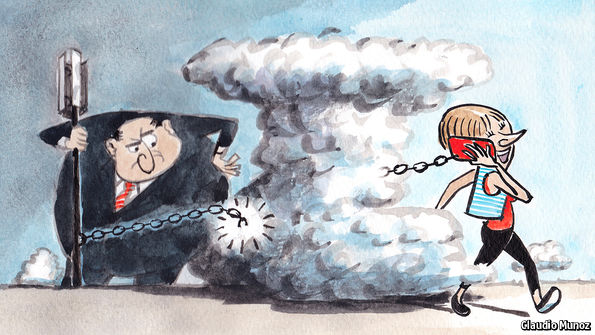
IN THE computing clouds, startups can set up new servers or acquire data storage with only a credit card and a few clicks of a mouse. Now imagine a world in which they could as quickly weave their own wireless network, perhaps to give users of a fleet of self-driving cars more bandwidth or to connect wireless sensors.
As improbable as it sounds, this is the logical endpoint of a development that is picking up speed in the telecoms world. Networks are becoming as flexible as computing clouds: they are being turned into software and can be dialled up and down as needed. Such “cloudification”, as it is known, will probably create as much upheaval in the telecoms industry as it has done in information technology (IT)
IT and telecoms differ in important respects. One is largely unregulated, the other overseen closely by government. Computing capacity is theoretically unlimited, unlike radio spectrum, which is hard to use efficiently. And telecoms networks are more deeply linked to the physical world. “You cannot turn radio towers into software,” says Bengt Nordstrom of Northstream, a consultancy.
The data centres of big cloud-computing providers are packed with thousands of cheap servers, powered by standard processors. Telecoms networks, by contrast, are a collection of hundreds of different types of computers with specialised chips, each in charge of a different function, from text messaging to controlling antennae. It takes months, if not years, to set up a new service, let alone a new network.
But powerful forces are pushing for change. On the technical side, the current way of building networks will hit a wall as traffic continues to grow rapidly. The next generation of wireless technologies, called 5G, requires more flexible networks. Yet the most important factor behind cloudification is economic, says Stéphane Téral of IHS Markit, a market-research firm. Mobile operators badly need to cut costs, as the smartphone boom ends in many places and prices of mobile-service plans fall. The shift was evident at the Mobile World Congress in Barcelona in February. Equipment-makers’ booths were plastered with diagrams depicting new technologies called NFV and SDN, which stand for “network-functions virtualisation” and “software-defined networks”. They turn specialised telecoms gear into software in a process called “virtualisation”.
Many networks have already been virtualised at their “core”, the central high-capacity gear. But this is also starting to happen at the edges of networks—the antennae of a mobile network. These usually plug directly into nearby computers that control the radio signal. But some operators, such as SK Telecom in South Korea, have begun consolidating these “baseband units” in a central data centre. Alex Choi, SK Telecom’s chief technology officer, wants “radio” to become the fourth component of cloud computing, after computing, storage and networking.
Spin me up, AT&T
The carrier that has pushed cloudification furthest is AT&T, America’s largest operator. By the end of 2017 it wants to have more than half of its network virtualised. In areas where it has already upgraded its systems, it can now add to the network simply by downloading a piece of software. “Instead of sending a technician, we can just spin up a virtual machine,” says Andre Fuetsch, AT&T’s chief technology officer.
Even more surprising for a firm with a reputation for caution, AT&T has released the program that manages the newly virtualised parts of its network as open-source software: the underlying recipe is now available free. If widely adopted, it will allow network operators to use cheaper off-the-shelf gear—much as the rise of Linux, an open-source operating system, led to the commoditisation of hardware in data centres a decade ago.
If equipment-makers are worried about all this, they are not letting it show. Many parts of a network will not get virtualised, argues Marcus Weldon, chief technology officer of Nokia. And there will always be a need for specialised hardware, such as processors able to handle data packets at ever faster speeds. Still, Nokia and other telecoms-gear-makers will have to adapt. They will make less money from hardware and related maintenance services, which currently form a big chunk of their revenues. At the same time, they will have to beef up their software business.
Cloudification may also create an opening for newcomers. Both Affirmed Networks and Mavenir, two American firms, for instance, are developing software to run networks on off-the-shelf servers. Affirmed already claims 50 customers. Mavenir wants to work with underdog operators “to bring the incumbents down”, says Pardeep Kohli, its chief executive. If the history of cloud computing is any guide, the telecoms world may also see the rise of new players in the mould of Amazon Web Services (AWS), the e-commerce giant’s fast-growing cloud-computing arm.
According to John Delaney of IDC, a research firm, the big barrier to cloudification is likely to be spectrum, which newcomers will still have to buy. But a clever entrepreneur may find ways to combine assets—unlicensed spectrum, fibre networks, computing power—to provide cheap mobile connectivity. Startups such as FreedomPop and Republic Wireless already offer “Wi-Fi first” mobile services, which send calls and data via Wi-Fi hotspots, using the mobile network as backup.
As the case of AWS shows, a potential Amazon Telecoms Services does not have to spring from the telecoms world. Amazon itself is a candidate. But carmakers, operators of power grids and internet giants such as Facebook could have a go: they are huge consumers of connectivity and have built networks. Facebook, for instance, is behind the Telecom Infra Project, another effort to open the network infrastructure. However things shake out, expect the telecoms world to become much more fluid in the coming years, just like IT before it
No comments:
Post a Comment
Note: Only a member of this blog may post a comment.